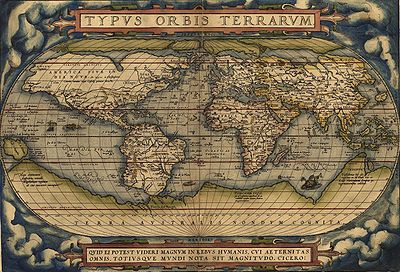Library of Sir Thomas Browne
The 1711 Sales Auction Catalogue of the Library of Sir Thomas Browne highlights the erudition of the physician, philosopher and encyclopedist, Sir Thomas Browne (1605-1682). It also illustrates the proliferation, distribution and availability of books printed throughout 17th century Europe which were purchased by the intelligentsia, aristocracy, priestly, physician or educated merchant-class.
Biography
Browne graduated from the University of Leiden in 1633 having previously studied at the Universities of Montpellier and Padua for his medical degree.[1] Upon his establishment in Norwich as a physician he was able to begin a lifetime's bibliophilia, building a private library, acquiring and reading an estimated 1,500 titles. He was adept in five contemporary languages: French, Italian, Spanish, Dutch and Danish; these languages as well as Greek and Hebrew and the predominant written form of the Renaissance, namely Latin, are all represented in his Library.
The catalogue
The 1711 Sales Auction Catalogue reflects the wide scope of Browne's interests. It includes many of the sources of his encyclopaedia Pseudodoxia Epidemica which went through six editions (1646 to 1672); and established him as one of the leading intellects of 17th-century Europe.
Browne's erudite learning is reflected by the Classics of antiquity as well as history, geography, philology, philosophy, anatomy, theology, cartography, embryology, medicine, cosmography, ornithology, mineralogy, zoology, travel, law, mathematics, geometry, literature, both Continental and English, the latest advances in scientific thinking in astronomy, chemistry as well as esoteric topics such as astrology, alchemy, physiognomy and the Kabbalah are all represented in the Catalogue of his library contents. It was however not until 1986 that the Catalogue was first made widely available. The American scholar Jeremiah Stanton Finch, Dean Emeritus at Princeton University took on the task of indexing Browne's work during his retirement,[2] completing the indexing of the books of Sir Thomas and his son Edward Browne's libraries, "after many years in many libraries".[3] Finch noted that the Catalogue advertised books of sculpture and painting, which somehow were never delivered to the auction house. In the event, the auction held upon 8–10 January 1711 was attended by Jonathan Swift and buyers working on behalf of Sir Hans Sloane. Thus an unknown percentage of books auctioned from the Library of Sir Thomas Browne subsequently formed the foundation for the future British Library.[3]
The 1711 Sales Auction Catalogue records the omnivorous reading and bibliophilia which Browne engaged upon for roughly sixty years, it also exemplifies the observation:
- to the student of the history of ideas in its modern sense of the inter-relationship between science, art and philosophy, Browne is of great importance.[4]
Greek literature
- Aeschylus, Sophocles, Euripides ed. Johannes Meursius Leiden 1612
- Archimedes, Opera 1615
- Aristotle Opera, 1615
- Rhetorica, 1619
- De Mundo, 1591
- Problemata, 1632
- Aristophanes Comedies XI, Leiden 1624

Frontispiece to 1657 edition of the Deipnosophists - Arrian, Ponti Euxini, Geneva 1577
- de Venatione, Paris 1644
- Apollonius of Rhodes Argonautica 2 vols. Leiden 1641
- Athenaeus, Deipnosophistae or Banquet of the learned ed. Isaac Casaubon 1612
- Epicurus Philosophy of, ed. Pierre Gassendi 2 vols. Leiden 1649
- Euclid Elementorum Libri 6. priores, London 1620
- Euripides Tragedies, 1562
- Homer Opera, Basle 1612
- Iamblichus, Life of Pythagoras
- The Mysteries of Egyptians and Chaldeans, Leyden 1670
- Lucian, Opera, 1546
- Dialogi Selectiores, Paris 1572
- Philo Opera, Cologne 1613
- Plato Chalcidii Timaeus, Leiden 1617 (ed. Johannes Meursius)
- Sibyllina Oracula, 1607
- Theophrastus Characters, notes by Isaac Casaubon, Leyden 1638
- Xenophon, Cyropaedia Gk & Lat London 1674
Roman literature
- Boethius, Consolation of Philosophy, 1653
- Censorinus, De die natali Leiden 1593
- Cicero, Dream of Scipio
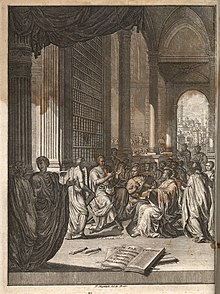
Frontispiece 1720 edition of Institutio Oratoria, showing Quintilian teaching rhetoric - Opera 2 vols. 1527
- Epistulae ad Familiares 1550
- Florus, Historia, Leiden 1655
- Hyginus, Fabulae Paris 1578
- Isidore of Seville, Originum 20 Books
- Martianus Capella, de nuptiis Philologiae et Mercurii, 1577
- Juvenal, Satyrae, Leyden 1523
- Macrobius, Somnium Scipionis (Dream of Scipio) 1556
- Marcus Aurelius, notes by Meric Casaubon, London 1643
- Ovid, Opera, London 1656
- Petronius, Satyricon, 1654
- Plautus, Comedies, with notes by Denis Lambin 1581
- Pliny the Elder, Naturalis Historia, Brussels 1496
- Propertius, cum Notis Varior. Traj. 1658
- Quintilian, Institutio Oratoria 1575
- Seneca, Tragedies, Leiden 1651
- Suetonius, Lives of the 12 Caesars, trans. Philemon Holland 1659
- Terence, Comedies, 1625
- Valerius Maximus, with notes, Leiden 1651
- Virgil, Opera, Amsterdam 1654
- Vitruvius, L'Architetturra di Vitruvio, tradotta & commentata da Daniele Barbaro Venice 1641
Arabic
- Alhazen Opticae Thesaurus Libri X, Basle 1572
- 'Ali ibn al-'Abbas al-Majusi Liber Totius Medicine Venice 1523
Contemporary science
- François d'Aguilon, Opticorum Libri 6, Antwerp 1613
- Petrus Apianus, Cosmographia, Antwerp 1545
- Mario Bettini, Beehives of Universal Philosophical Mathematics 1656
- Isaac Barrow, Euclid's Elements, London 1660
- Antonio Bosio, Roma Subterranea cum. fig. 3 Tomi in 1 vol. Cologne 1659
- Robert Boyle, Usefulness of Experimental Philosophy, London 1671
- Henry Briggs, Arithemica Logarithmica, London 1644

Frontispiece and title page of Galileo's Dialogue, 1632 - Alessandro Piccolomini, De Sphaera, Basle 1565
- Thomas Digges, Alae seu Scalae Mathematicae, London 1573
- Thomas Fincke, Geometria Rotundi, Basle 1583
- Galileo, Dialogue Concerning the Two Chief World Systems, Trent 1635
- Sidereus Nuncius, London 1653
- Two World Systems Englished by T. Sainsbury, 1661
- William Gilbert. De Magnete, Magneticisque Corporibus, et de Magno Magnete Tellure 1600
- Sir Matthew Hale's Observat. touch. the Torricelli Experiment 1674
- Jean-Baptiste du Hamel, de meteoris & fossilbus, Paris 1660
- de consensu Vet. & Novae Philosophiae Paris 1663
- de Corpor. affectionib. Paris 1670
- Robert Hooke, Lectures, London 1678
- Christian Huygens, Systema Saturnium, The Hague 1659
- Johannes Kepler, Mysterium Cosmographicum, Tübingen 1596
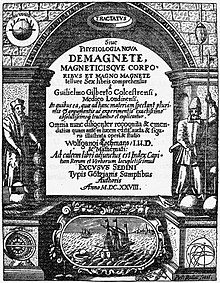
De Magnete Title page of 1628 edition - de Stella nova in pede Serpentis, Prague 1606
- ad Vitellionem Paralipomena, Frankfurt 1604
- Fortunio Liceti De lucernis antiquorum reconditis, Udine 1652
- Antiqua Schemata Gemmar. Anular. cum fig., 1653
- De spontaneo viventium ortu libri quatuor, Vicenza 1618
- De his, qui diu vivunt sine alimento, Padua 1612
- De quaesitis per epistolas a claris viris responsa, Bologna 1640
- De Terra & de Lucidis in Sublimi, Udine 1640
- De lapide Bononiensi & Qualitis, Udine 1640
- De regulari motu minimaque parallaxi cometarum coelestium disputationes, Udine 1640
- Jan Marek Marci Idearum Operatricum Idea Hannover 1635
- William Oughtred, Clavis Mathematica London 1648
- Georg Purbach, Theoricae novae Planetarum, Basle 1568
- Regiomontanus, Tabulae Directionum & Prosectionum, 1551
- Robert Recorde, Whetstone of Witte, 1557
- Christoph Scheiner, Rosa Ursina sive Sol Bracciano, 1630
- Gaspar Schott, Magia Universalis Natura Artis 4 vols.Würtzburg 1657
- John Speed, History of Great Britain, 2nd ed. 1627
- Niccolò Fontana Tartaglia, Euclide reaffettato & alla Integrita ridotto 1543
- Godefroy Wendelin Of the cause of purple rain in Brussels, Brussels 1647
Philosophy
- Francis Bacon, Advancement of Learning, 1628
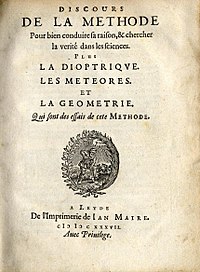
Descartes Discourse on Method - Natural History, 1628
File:Pascal - Pensées, édition de Port-Royal, 1670.djvu Blaise Pascal's Pensées - Opuscula Philosophica, 1658
- Natural History, 1628
- Bellarmine, Apologia pro Jure Princip., 1611
- Charles de Bovelles Liber de intellectu. Liber de sensibus. Liber de generatione. Libellus de nihilo. Ars oppositorum. Liber de sapiente. Liber de duodecim numeris. Philosophicae epistulae. Liber de perfectis numeris. Libellus de mathematicis rosis. Liber de mathematicis corporibus. Libellus de mathematicis supplementis Paris 1510
- René Descartes, Discourse on Method, 1637, 1st edition
- Méditations, 1644
- Meditationes de prima Philosophia, Amsterdam 1644
- Principia Philosophia, Amsterdam 1656
- Lettres, Paris 1657
- de la Lumière &c., Paris 1664
- les Passions de l'âme, Amsterdam 1650
- Compendium of Musick, London 1653
- Of a Method for the well-guiding of Reason, London 1649
- Thomas Hobbes, Elementorum Philosophiae Sectio Secunda de Homine, 1658
- Elementa Philosophica de Cive 2nd edit., Amsterdam 1647
- Justus Lipsius, Opera, 4 Tomi in 3 vol., Antwerp 1637
- Jan Gruter, Inscriptiones antiquae totius orbis Romani, 2 vols. Heidelberg 1603
- Machiavelli, History of Florence, Strasbourg 1610
- Blaise Pascal, Pensées 1670
- Discours sur les mêmes Pensées, 1672
- Francis Osborne Collected Works 1675
Theology
- Augustine of Hippo, City of God, 1620
- Thomas Aquinas, Summa Theologiae, Paris 1638
- Richard Baxter, Reasons of the Christian Religion 1667
- Samuel Bochart, Geographica sacra seu Phaleg et Canaan, cum. Tabul Geograph. Caen 1642
- Jean Bodin, Demonomania, Basle 1581
- Johannes Buxtorf, Lexicon Chaldaic.Talmudic & Rabbinic Basle 1639
- Epitome Grammaticae, Hebraea London 1653
- Lexicon Hebraic.& Chaldaic London 1646
- Epitome Grammaticae Hebraea Basle 1629
- Clement of Alexandria, Opera, Paris 1629
- Ralph Cudworth, On the true Notion of the Lord's Supper, London 1642
- Pseudo-Dionysius the Areopagite, Opera, Basle 1571
- Erasmus, Preparations for death, Basle 1532
- Joseph Hall, Works, vol. 1st and 3rd London 1647,1662
- Justin Martyr Opera Paris 1636
- Jerome Opera 9 Tomi, in 4 vol Paris 1643
- Martin Luther, Commentary on the Epistle to the Galatians, 2nd edit. 1577
- Marin Mersenne, Questions in Genesis, Paris 1623
- Benito Arias Montano, New Testament, Greek & Latin Geneva 1619
- Sebastian Münster, Opus Grammat. (Hebrew), Basle 1542
- Grammatica Chaldaica, Basle 1527
- Rabbi Abrahami Sphaera Mundi (Hebrew), Latinized 1546
- Alexander Nowell Catechism 1575
- Origen, Opera, Basle 1571
- James Usher de Textus Hebraei V. variantib. Lectionibus, London 1652
Medical
- Avicenna Opera, 2 vols. 1608 Venice
- Thomas Bartholin Anatomia Reformata, Leyden 1651
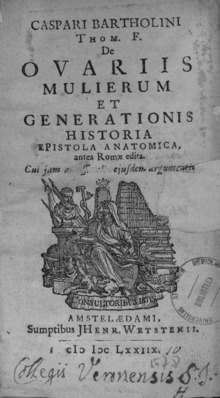
De ovariis mulierum et generationis historia epistola anatomica, 1678 - de Medicina Danorun Domestica, Hannover 1666
- de Luce Animalium, Leyden 1647
- Historiar. Anatomic. rarior. Cent. VI, 3 vol. Hannover 1654
- de Pulmonum Substantia et Motu, Hannover 1663
- de Lacteis Thoracicis, London 1652
- de Ovariis Mulierum & Generat. Historia, 1678
- Gerolamo Cardano Opera, 10 vol. Leyden 1663
- Aulus Cornelius Celsus De Medicina 8 Libri Basle 1592

Cornelius Celsus De medicina - Realdo Colombo De Re Anatomica Libri XV Venice 1559

Title page of Colombo De Re Anatomica - Pedanius Dioscorides Opera, 1598
- Parabilia, 1598
- Charles Estienne De dissectione Corporis humani, 1545
- Hieronymus Fabricius Opera Anatomica, Paris 1625
- De Visione, Voce & Auditu, Venice 1600
- Ab Aquapendente Opera Chirurgica, Venice 1619
- Fallopius, Opera, Frankfurt 1600
- Jean Fernel, Cosmotheoria, 1528
- Leonhart Fuchs, de humani Corporis fabrica Leiden 1551
- Paradoxor. Medicinae Libri 3 Venice 1547
- Galen, Opera, 5 books in 3 vols. Basle 1538
- Pierre Gassendi,Vita Epicuri, Leiden 1647
- de apparente magnitudine solis humilis et sublimis, Paris 1642
- Instit. Astronomia item Galileo et Kepler, 1683
- Exercitatio Anatomica de Motu Cordis et Sanguinis in Animalibus, 1648
- Francis Glisson, De ventriculo & Intestinis, London 1677
- de Rachitide, London 1650
- Jonathan Goddard Unhappy condition of Practice of Physick in London, 1670
- Johannes Goropius Becanus Origines Antwerpianae 1569
- William Harvey, De Generatione, London 1651
- Hippocrates Opera 1624
- Aphorismi & Prognost in Greek and Latin, ed. Jo. Butino 1625
- Coacae Praenotiones, notes by John Johnson, Amsterdam 1660
- de Morbis Mulierum, Paris 1585
- Praenotiones, Paris 1585
- Marcello Malpighi De viscerum structura, London 1669
- de formatione Pulli in Ovo, London 1673
- de Viscerum Structura, London 1669
- Adrian von Mynsicht Thesaurus et Armamentarium Medico-Chymicum 1631
- Jan Swammerdam, Uteri Muliebris Fabrica, London 1680
- of Respiration, Leiden 1667
- Thomas Sydenham, Observationes Medical., London 1676
- de Podagra & Hydrope, London 1683
- Schedula Monitoria de nova Febris Ingressu, London 1686
- Epist. duae de Morbis Epidem. & de Lue Venera, London 1680
- Dissertatio Epistolaris, London 1682
- Walter Charleton, Enquiries into Human Nature, 1680
- Darkness of Atheism dispelled by Nature's Light, 1652
- Henry Martini,Anatomia Urinae Galeno-Spagyrica, Frankfurt 1659
- George Ent, Apolog. pro Circulatione Sanguinis adv. et Parisanum, London 1641
- Franz de la Boe a.k.a. Franciscus Sylvius
- Thomas Willis, Opera varia, 5 vols. London 1664
- Cerebri Anatome cum fig., London 1664
- Richard Lower, De Corde: item de motu & colore sanguinis, London 1670
- Julius Caesar Scaliger, On Insomnia, Geneva 1610
- Vesalius, De humani corporis fabrica 8 Books 1555
- Jacques Dubois aka Jacobus Sylvius de Signis omnib. Medicis Paris 1630
Esoteric
- Elias Ashmole ed., Theatrum Chemicum Britannicum, 1652

Theatrum Chemicum Britannicum - J.J. Becher Physica subterranea Frankfurt 1669
- Guido Bonatti de Astronomica Tract 1550
- Tommaso Campanella, 7 Astrological books, Frankfurt 1630
- Jerome Cardan Opera omnia 10 vols. Leiden 1663
- Arthur Dee, Fasciculus Chemicus
- Marsilio Ficino, Theologia Platonica de Immortalitate Animorum, Paris 1559
- Jacques Gaffarel, Unheard-of Curiosities, Paris 1650
- Francesco Giorgi, De harmonia mundi, Venice 1525
- Johann Glauber, de natura Salium, Amsterdam 1658
- Lucas Gauricus, super Dieb. Decretoriis sive Criticis Axiomata Rome 1546
- Helvetius, Miraculo transmutandi Metallica, Antwerp 1667

Frontispiece of English translation of Natural Magick London (1658) - Athanasius Kircher, Ars Magna Lucis et Umbrae, Rome 1646
- Obeliscus Pamphilius, Rome 1650
- Oedipus Aegyptiacus, Rome 1652
- Magnes sive de Arte Magnetica, Rome 1654
- Mundus Subterraneus, 2 Vols. Amsterdam 1665
- Heinrich Khunrath Medulla Distillatoria & Medica. Hamburg 1638
- Raymund Lull, Vademecum, quo sontes Alchemica Art, 1572

Page One of Theatrum Chemicum Vol. I (1602) - Pierio Valeriano Bolzani Hieroglyphica sive de sacris Aegyptiorum litteris 1631
- Pico della Mirandola Cabalistarum Selectiora Obscurioraque Dogmata, Venice 1569
- Jean-Baptiste Morin Astrologica Gallica 1661
- Paracelsus, Opera Medico-Chimica, Frankfurt 1603
- Petrae, Nosologia Harmonica Dogmatica et Hermetica, 1615
- Giambattista della Porta, Natural Magic, 1644
- Villa, 12 Books Frankfurt 1592
- Phytognomica, Naples 1588
- Coelestis Physiogranonia, Naples 1603
- de Miracoli & Maravigliosi Effetti dalla Natura prodotti, Venice 1665
- William Ramsay, Judicial Astrology vindicated 1651
- Henry Ranzovus, Astrologia Scientiae Certitudo, 1585
- Martin Ruland, Dictionary of alchemy, 1612
- Sendivogius, The true secret Philosophy, Castille 1651
- Oswald Schreckenfuchs Commentaries on George Peurbach Basle 1569
- Theatrum Chemicum, 5 vols inc. vol. 1 Gerhard Dorn Strasbourg 1613
- Johannes Trithemius, Polygraphiae Libri 6., Cologne 1571
- Basil Valentine, Currus Triumphalis, with fig., Amsterdam 1671
- Thomas Vaughan, A Hermeticall Banquet drest by a Spagyrical Cook, 1652
- Blaise de Vigenère, Tract du Feu & du Sel, Rouen 1642
- Vossius, De Idolatria (1642)
- Johann Weyer, Opera, Amsterdam 1660
Natural history
- Georg Agricola, de Re Metallica, Basle 1621
- de Ortu & Causis Subterraneor, Basle 1558
- Ulisse Aldrovandi, Museum Metallicum cum fig, Bologna 1648
- Serpentium and Draconum historia cum fig., Bologna 1640
- Ornithtologia sive de Avibus Historia, cum fig., Frankfurt 1610

Aldrovandi's Ornithology - Quadrupedum Bisulcorum Historia, cum fig Bologna 1642
- de Quadrupedib. Digitatis Viviparis & Oviparis 1637
- de Quadupedib. Animalibus & Piscibus Frankfurt 1610
- Monstror. Historia, cum fig. Bologna 1642
- Prospero Alpini, de Medicina Medicae, Patav. 1611
- de Plantis Egypti, Patav. 1640
- de Medicina Egypti, 1646
- de praesagienda Vita & Morte Aegrotantium, Venice 1601
- J. Bauhin, Historica Plant., 3 Vols. 1650
- Hist. Fontis & Balnei Bollenis, Montpellier 1598
- C. Bauhin, Prodomus Theatri Botanici, Frankfurt 1620
- Pinax Theatri Botanici, Basle 1623
- de Hermaphroditor. Natura, 1614
- J.J. Becher, Physica Subterranea, Frankfurt 1669
- Pierre Belon, Histoire de la Nature des Oiseaux avec leurs Descriptions & naises traits retirez du Naturel, Paris 1555
- Carolus Clusius Exoticorum libri decem Leiden 1605

Carolus Clusius Exoticorum libri decem - Stripium novae descrip. cum fig. Leiden 1611
- Conrad Gessner, Opera, 4 vols. Zurich 1551
- de Avibus, cum fig. illuminatus
- Epistolae Medicinales Zurich 1577
- Thomas Muffet, De Insect cum fig, London 1634
- Nosomantica Hippocratea, Frankfurt 1588
- John Ray, Catalogus Plantar. Angliae, London 1670
- Historia Plantarum, London 1670
- Guillaume Rondelet De Piscibus Marinis 1554
- Nicolas Steno, Concerning Solids naturally contained within solids, 1671
- Elementor Myologiae Specimen, cum fig., Amsterdam 1669
- Observationes Anatomicae cum fig., Leiden 1662
- de Cerebri Anatome, Leiden 1671
- Francis Willughby, Ornithologia, cum fig. London 1676
- Olaus Wormius, Museum Wormianum, Leyden 1655
Literature
- Dante, La Terza Rima
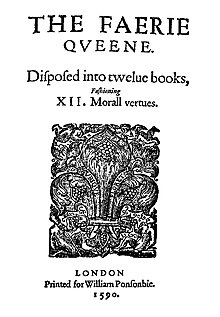
The Faerie Queene frontispiece - George Herbert, The Temple, sacred poems, Cambridge 1641
- Milton, Paradise Lost, 1674
- Paradise Regained, with Samson Agonistes, 1671
- Abraham Cowley, Poems, with his Davideis 1656
- Edmund Spenser Works, 1679
- The Faerie Queene in 12 books, 1609
- Ben Jonson, Works, 2 Vols. 1616/1640
- Edmund Gayton's Pleasant notes upon Don Quixote 1654
Geography and history
- Thomas Fuller, A Pisgah-Sight of Palestine with maps, 1650
- John Greaves, A description of the Grand Signiors Seraglio 1650
- Saxo Grammaticus, Gesta Danorum Paris, 1514
- James Howell, Of the Precedency of Kings, 1664
- Athanasius Kircher, China Illustrata, Amsterdam 1667
- Gerardus Mercator, Atlas sive Cosmographicae Meditationes de Fabrica Mundi et Fabricati Figura, Amsterdam 1613
- Claude Mydorge, Examen du Livre des recreations Mathematiques, Paris 1639
- Abraham Ortelius, Theatrum Orbis Terrarum Antwerp 1574
- Thesaurus Geographic. recognit. & auctus 1611
- Itinerar. per Galliae Belgicae partes Plant. 1584
- Strabo Geographia 17 Books Commentary Isaac Casaubon Paris 1620
- Of the Kingdom of Naples, 1654
- Of the Signorie of Venice, 1651
- Of Hungary and Transylvania, 1664
- Instructions for Foreign Travels, 1642
Miscellaneous
- Thomas Morley, A Plaine and Easie Introduction to Practicall Musicke London 1597
- Valentin Schindler, Lexicon Pentaglotton Hebraic., Chaldic., Syrian., Arabic., 1612
- Artificia Hominum, Miranda Naturae, in Sina & Europa, 1655
- Ethiopian Dictionary 1674
Source
- A Facsimile of the 1711 Sales Auction Catalogue of Sir Thomas Browne and his son Edward's Libraries. Introduction, notes and index by J.S. Finch (E.J. Brill: Leiden, 1986)
See also
- Music, mysticism and Magic – A sourcebook ed. Joscelyn Godwin pub. Arkana 1986
- The greatest benefit to Mankind. A medical history from antiquity to the present. Roy Porter Harper and Collins 1999
References
- ^ R. H. Robbins, 'Browne, Sir Thomas (1605–1682)', Oxford Dictionary of National Biography, Oxford University Press, 2004; online edn, May 2008 accessed 16 Feb 2013
- ^ Obituary, Princeton University, accessed February 2013, Ruth Stevens
- ^ a b A Facsimile of the 1711 Sales Auction Catalogue of Sir Thomas Browne and his son Edward's Libraries. Introduction, notes and index by J.S. Finch (E.J. Brill: Leiden, 1986) Page 7
- ^ The Strategy for Truth – Leonard Nathanson Chicago University Press 1967
External links
- Aquarium of Vulcan:Library of Sir Thomas Browne [1]















